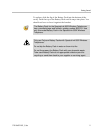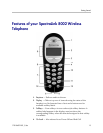
Getting Started
1725-36027-001_C.doc 17
Handset Modes
Standby mode (on-hook)
In standby mode, the handset is waiting for an incoming call or for
the user to place an outgoing call. The extension number is shown on
the display and there is no dial tone. In this mode, the handset is
conserving battery power and wireless LAN bandwidth.
When an incoming call occurs, the handset will ring, and the handset
enters the active mode until the call is answered by pressing the
Start
Call key or the Answ softkey. The handset will ring according to user
preference as specified in the standby menus. The ringing can be
silenced by pressing the
End Call key. If you do not wish to accept the
call, press the
Rej softkey. The SIP server (if present) will redirect the
call as configured by the system administrator, often to voicemail.
(Treated like the handset is busy.)
Active mode (off-hook)
The handset is in the active mode when an incoming call is answered
or when it is in communication with the SIP server without being in
an active call.
When an incoming call occurs during an active call, the handset will
play the second call ringing sound until the call is answered, the caller
hangs up, or the call transfers to voicemail. If
End Call is pressed, the
first call is terminated and the handset reverts to a full ring.
The active modes utilize the most bandwidth and battery power. To
conserve these resources, return the handset to the standby mode
when a call is completed by pressing the
End Call key.
Messaging mode
If text messaging functions have been programmed, as in a nurse call
system, the handset is able to receive text messages. While these
messages are being accessed, the handset is in messaging mode.
Incoming calls will ring with the second call ringing sound.


















